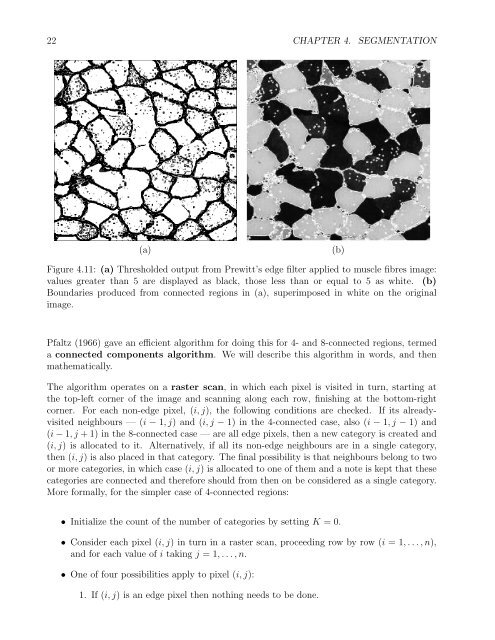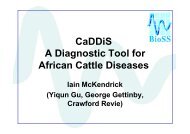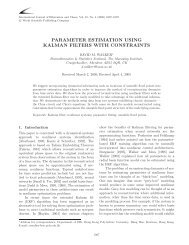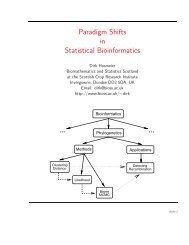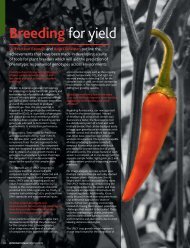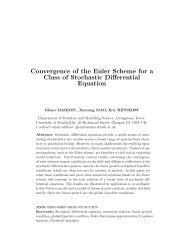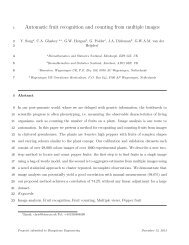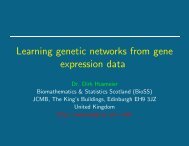22 CHAPTER 4. <strong>SEGMENTATION</strong>(a)(b)Figure 4.11: (a) Thresholded output from Prewitt’s edge filter applied to muscle fibres image:values greater than 5 are displayed as black, those less than or equal to 5 as white. (b)Boundaries produced from connected regions in (a), superimposed in white on the originalimage.Pfaltz (1966) gave an efficient algorithm for doing this for 4- and 8-connected regions, termeda connected components algorithm. We will describe this algorithm in words, and thenmathematically.The algorithm operates on a raster scan, in which each pixel is visited in turn, starting atthe top-left corner of the image and scanning along each row, finishing at the bottom-rightcorner. For each non-edge pixel, (i, j), the following conditions are checked. If its alreadyvisitedneighbours — (i − 1,j) and (i, j − 1) in the 4-connected case, also (i − 1,j − 1) and(i − 1,j+ 1) in the 8-connected case — are all edge pixels, then a new category is created and(i, j) is allocated to it. Alternatively, if all its non-edge neighbours are in a single category,then (i, j) is also placed in that category. The final possibility is that neighbours belong to twoor more categories, in which case (i, j) is allocated to one of them and a note is kept that thesecategories are connected and therefore should from then on be considered as a single category.More formally, for the simpler case of 4-connected regions:• Initialize the count of the number of categories by setting K =0.• Consider each pixel (i, j) in turn in a raster scan, proceeding row by row (i =1,...,n),and for each value of i taking j =1,...,n.• One of four possibilities apply to pixel (i, j):1. If (i, j) is an edge pixel then nothing needs to be done.
4.2. EDGE-BASED <strong>SEGMENTATION</strong> 232. If both previously-visited neighbours, (i − 1,j) and (i, j − 1), are edge pixels, thena new category has to be created for (i, j):K → K +1, h K = K, g ij = K,where the entries in h 1 ,...,h K are used to keep track of which categories are equivalent,and g ij records the category label for pixel (i, j).3. If just one of the two neighbours is an edge pixel, then (i, j) is assigned the samelabel as the other one:{gi−1,j if (i, j − 1) is the edge pixel,g ij =otherwise.g i,j−14. The final possibility is that neither neighbour is an edge pixel, in which case (i, j) isgiven the same label as one of them:g ij = g i−1,j ,and if the neighbours have labels which have not been marked as equivalent, i.e.h gi−1,j ≠ h gi,j−1 , then this needs to be done (because they are connected at pixel(i, j)). The equivalence is recorded by changing the entries in h 1 ,...,h K , as follows:– Set l 1 = min(h gi−1,j ,h gi,j−1 ) and l 2 = max(h gi−1,j ,h gi,j−1 ).– For each value of k from 1 to K, ifh k = l 2 then h k → l 1 .• Finally, after all the pixels have been considered, the array of labels is revised, taking intoaccount which categories have been marked for amalgamation:g ij → h gijfor i, j =1,...,n.After application of the labelling algorithm, superfluous edge pixels — that is, those whichdo not separate classes — can be removed: any edge-pixel which has neighbours only of onecategory is assigned to that category.Fig 4.11(b) shows the result of applying the labelling algorithm with edges as shown in Fig 4.11(a),and removing superfluous edge pixels. The white boundaries have been superimposed on theoriginal image. Similarly, small segments (say less than 500 pixels in size) which do not touchthe borders of the image can be removed, leading to the previously displayed Fig 4.1(b). Thesegmentation has done better than simple thresholding, but has failed to separate all fibres becauseof gaps in output from Prewitt’s edge filter. Martelli (1976), among others, has proposedalgorithms for bridging these gaps.Another edge-detection filter considered in chapter 3 was the Laplacian-of-Gaussian (§3.1.2).This filter can also be used to segment images, using the zero-crossings of the output to specifypositions of boundaries. One advantage over Prewitt’s filter is that the zero-crossings alwaysform closed boundaries. Fig 4.12(a) shows output from the Laplacian-of-Gaussian filter


